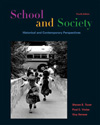 |  School and Society: Historical and Contemporary Perspectives, 4/e Stephen E. Tozer,
The University of Illinois, Chicago
Paul C. Violas
Guy Senese,
Northern Arizona University
Conclusion
Learning ObjectivesAmong the objectives that Chapter 15 seeks to achieve are these:
| Students should be able to explain the sense in which the family, the community, the school, and the peer group provide four different cultural contexts for children and youth. |
 |  |  | | Students should be able to explain the meaning of "youth culture" and be able to assess why it is important for an educator to understand it. |
 |  |  | | Students should be able to discuss whether family culture and local community culture are different ways of referring to the same thing and the differences between the two. |
 |  |  | | Students should be able to provide examples of how youth culture intersects with the local community culture. |
 |  |  | | Students should be able to discuss why it is important to work with the families of their students. |
 |  |  | | Students should be able to identify obstacles that may impede productive school-family interactions and how teachers can make these interactions more productive. |
 |  |  | | Students should be able to evaluate the kinds of parental involvement that they believe are the most important for teachers to promote. |
|



 2002 McGraw-Hill Higher Education
2002 McGraw-Hill Higher Education